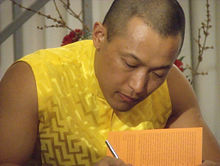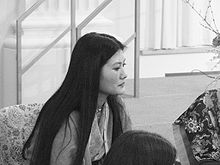- Sakyong Mipham
-
Sakyong Mipham Rinpoche 
Religion Kagyü and Nyingma School Shambhala Buddhist Lineage Chogyam Trungpa Personal Born 1962 Religious career Reincarnation Mipham the Great Sakyong Mipham Tibetan name Tibetan: ས་སྐྱོང་མི་ཕམ་ Wylie transliteration: Sa-skyong Mi-pham Sakyong Jamgon Mipham Rinpoche, Jampal Trinley Dradul (born Osel Rangdrol Mukpo in 1962) is the head of the Shambhala Buddhist lineage and Shambhala International, a worldwide network of urban Buddhist meditation centers, retreat centers, monasteries, a university, and other enterprises, founded by his father, the Buddhist teacher Chögyam Trungpa Rinpoche (XI Trungpa Tulku). Sakyong Mipham Rinpoche is a high lama in the Nyingma lineage of Tibetan Buddhism. He is believed to be the second incarnation of Mipham the Great, who is revered in Tibet as an emanation of Manjushri, the bodhisattva of wisdom. Rinpoche is an honorific (meaning "precious one" in Tibetan) commonly afforded to tulkus.
Contents
Biography
Sakyong Mipham Rinpoche was born Ösel Rangdröl Mukpo in 1962 in Bodhgaya, India. He spent his early years with his mother, Lady Kunchok Palden, in a Tibetan refugee village in northwest India, where he began his study of Buddhism. At the age of seven, he went to live with his father in the United Kingdom. His father moved to the United States in 1970, and Osel Mukpo rejoined him there two years later, where his education continued. He also began to receive training in various contemplative arts such as kyūdō (Japanese archery), calligraphy, and horsemanship.[1]
The Sakyong also received many teachings from many of the great contemporary teachers of Tibetan Buddhism, in particular Penor Rinpoche, supreme head of the Nyingma lineage. The Nyingma teacher, Dilgo Khyentse Rinpoche, was like a grandfather to the Sakyong. After the death of his father in 1987, the Sakyong moved to Nepal and studied with Dilgo Khyentse Rinpoche until Khyentse's death in 1991.
In 1995, with many dignitaries in attendance and much celebration, Ösel Rangdröl was formally enthroned as Sakyong and confirmed as the rebirth of Mipham the Great. Penor Rinpoche performed the ceremony.
Dharma activity
Part of a series on
Buddhism
Dharma or concepts
Four Noble Truths
Five Aggregates
Impermanence
Suffering · Non-self
Dependent Origination
Middle Way · Emptiness
Karma · Rebirth
Samsara · CosmologyPractices
Three Jewels
Noble Eightfold Path
Morality · Perfections
Meditation · Mindfulness
Wisdom · Compassion
Aids to Enlightenment
Monasticism · LaityNirvāṇa
Four Stages · Arahant
Buddha · BodhisattvaTraditions · Canons
Theravāda · Pali
Mahāyāna · Chinese
Vajrayāna · TibetanIn 2001 Sakyong Mipham visited Tibet for the first time. Here he was greeted by thousands of people, not only as the Sakyong and the rebirth of Mipham, but also as living proof of the vitality of Buddhism, returning to the place that his father had left in 1959. Huge audiences gathered to hear his teachings and receive his blessings. Choseng Trungpa, the Twelfth Trungpa Tulku, along with the other tulkus and leaders of Surmang, asked him to assume stewardship of the Surmang monasteries and their people. While in Tibet he was also asked to assume responsibility for Weyen monastery, the Gesar orphanage, and the Mipham Institute in Golok, and Khamput Monastery in Kham; his support for all of these is now directed through the Kunchok Foundation.
In 2004 he returned to India to meet for the first time with Karmapa Ogyen Trinley Dorje, and also journeyed back to Tibet to visit the monasteries under his care.
The Sakyong continually maintains his personal meditation, study, and writing. He travels extensively, teaching throughout the world. He is a poet and an artist. He enjoys golf, running, horseback riding, and yoga.
Lineage of Sakyongs
The Sakyong holds and propagates the teachings of Shambhala, an enlightened society. This tradition emphasizes confidence in the basic goodness of all beings and teaches courageous rulership based on wisdom and compassion. The term "Sakyong" literally means "earth-protector" in Tibetan, although it is colloquially understood to mean "king". Sakyong Mipham Rinpoche is regarded as a chögyal (Sanskrit dharmaraja) – "king of truth" – who combines the spiritual and worldly paths. The first Dharmaraja of Shambhala, Dawa Sangpo, was said to have been empowered directly by the Buddha. The Sakyong is the earthly embodiment or emanation of the Rigden — enlightened awareness — and in this sense he is a tulku (Tibetan), or nirmanakaya (Sanskrit) of the Rigden.
Chögyam Trungpa Rinpoche is regarded as the first in this lineage of Sakyongs, and as such he is referred to as the "Druk Sakyong", or "Dragon Earth-Protector". In 1978, Chögyam Trungpa Rinpoche performed a ceremony officially confirming Ösel Rangdröl as his Shambhala heir and the future Sakyong.[2]
Sakyong Wangmo
The consort of the Sakyong is referred to as the Sakyong Wangmo. The first Sakyong Wangmo was Chögyam Trungpa Rinpoche's widow, Lady Diana Mukpo. The present Sakyong Wangmo is Khandro Tseyang Ripa Mukpo, daughter of His Eminence Terton Namkha Drimed Rabjam Rinpoche, to whom Sakyong Mipham Rinpoche was married on June 10, 2006 in Halifax, Nova Scotia.[3][4] The marriage event was largely publicized and included a lhasang held at Citadel Hill National Historic Site. Khandro Tseyang was recently empowered as Sakyong Wangmo in a ceremony held in Halifax, Nova Scotia. Sakyong Mipham Rinpoche and Khandro Tseyang Ripa Mukpo have a baby girl named Drukmo Yeshe Sarasvati Ziji Mukpo (Lady Dragon Wisdom), born August 11, 2010.
Bibliography
Books
- Ruling Your World: Ancient Strategies for Modern Life, Morgan Road Books, 2005, ISBN 0-7679-2065-1
- Turning the Mind into an Ally, Riverhead Books, 2004, ISBN 1-57322-345-X
Articles
- It's All in the Mind in Shambhala Sun, November 2006.
See also
- Shambhala Training
- Rigden kings
Notes
References
- Hayward, Jeremy (2007) Warrior-King of Shambhala: Remembering Chogyam Trungpa ISBN 0-86171-546-2
External links
- Sakyong Mipham Rinpoche's homepage
- Interview with Sakyong Mipham Rinpoche on relationships, loneliness and "Ruling Your World."
Buddhism Categories:- 1962 births
- Living people
- Kagyu
- Lamas
- Nyingma
- Rinpoches
- Tibetan people
- Tulkus
- Tibetan Buddhists from India
- Non-traditional Buddhism
Wikimedia Foundation. 2010.


